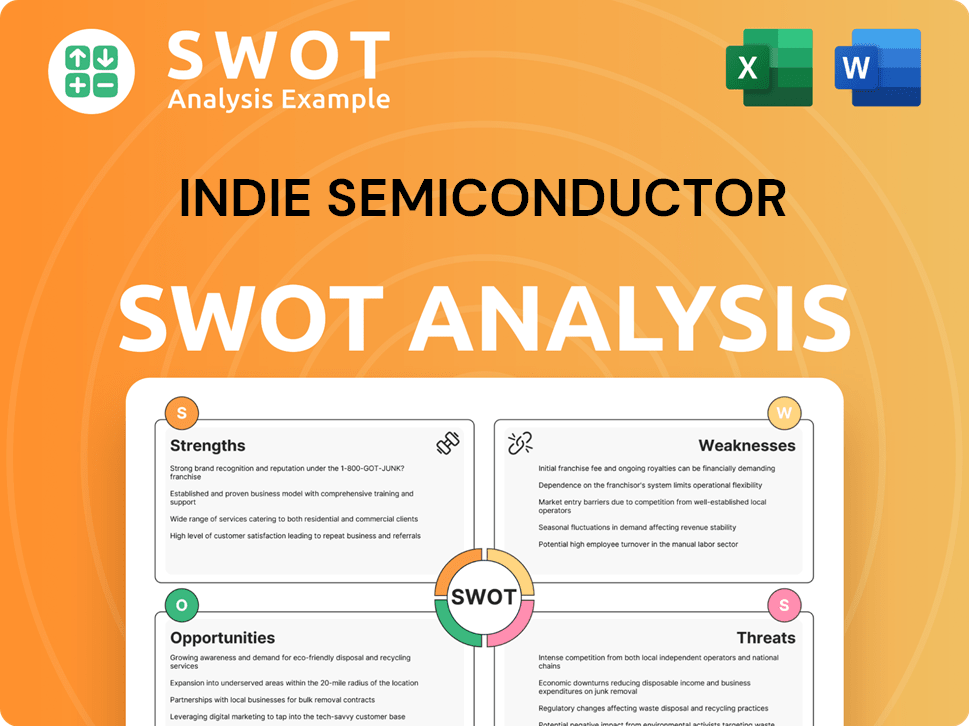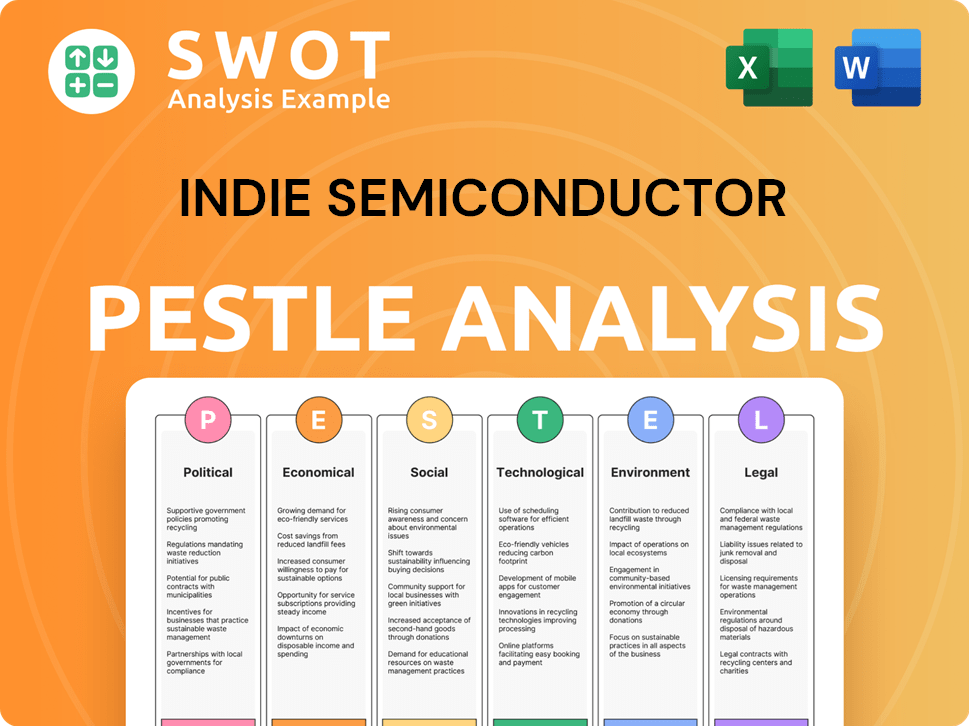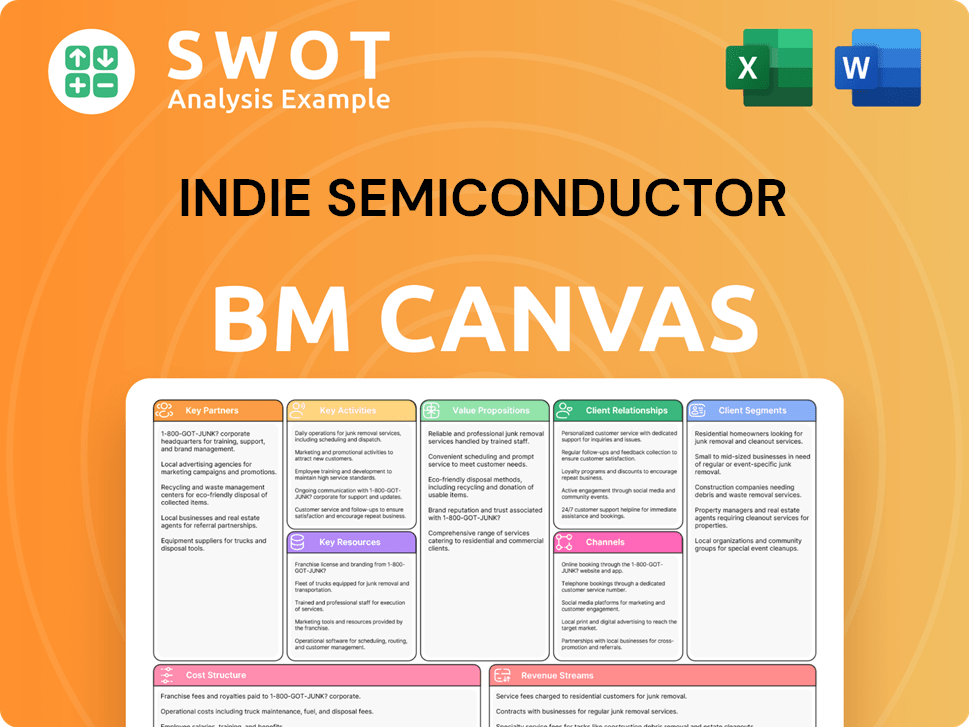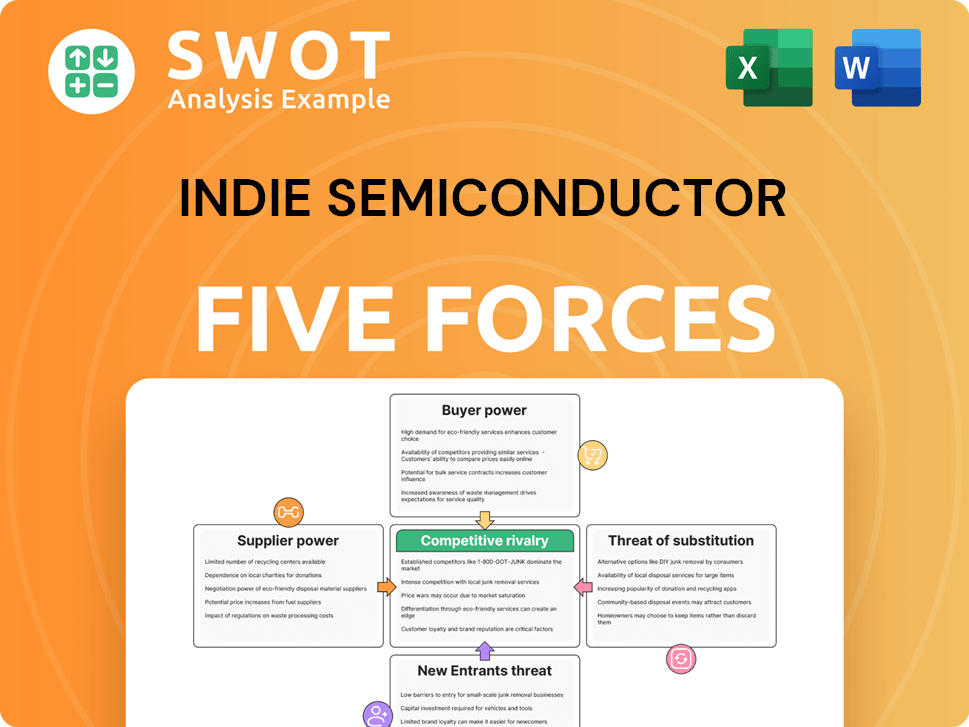indie semiconductor Bundle
Can indie Semiconductor Conquer the Automotive Semiconductor World?
The automotive industry is undergoing a massive transformation, fueled by advancements in autonomous driving and electric vehicles. This shift has created a dynamic indie semiconductor SWOT Analysis for innovative companies like indie Semiconductor. But how does this startup navigate the complex semiconductor industry and compete with established giants?

This deep dive into the competitive landscape of indie Semiconductor will provide a thorough market analysis. We'll explore the company's journey, from its origins in Aliso Viejo to its current position as a key player in automotive technology, examining its core strengths and the challenges it faces in this rapidly evolving sector. Understanding indie Semiconductor's strategy is crucial for anyone looking to understand the future of automotive innovation.
Where Does indie semiconductor’ Stand in the Current Market?
indie Semiconductor has carved out a significant position within the automotive semiconductor industry, particularly in the burgeoning Advanced Driver-Assistance Systems (ADAS) and autonomous vehicle sectors. The company focuses on providing highly integrated System-on-Chip (SoC) solutions, which are essential for various edge sensors such as radar front-ends, lidar signal chains, computer vision processors, and ultrasonic sensors. These solutions are designed to meet the needs of a broad spectrum of automotive applications, ranging from basic parking assistance to advanced autonomous driving features.
The company's strategic approach involves offering comprehensive, integrated solutions rather than just discrete components. This shift is a direct response to the industry's move towards software-defined vehicles and centralized architectures, allowing indie Semiconductor to capture a larger share of the value chain. This strategic positioning has been instrumental in its recent financial performance and market penetration. The company's focus on innovation and integration has allowed it to secure design wins and expand its market presence.
Geographically, indie Semiconductor maintains a global presence, serving key automotive manufacturing hubs across North America, Europe, and Asia. Its customer base primarily comprises leading automotive Tier 1 suppliers and OEMs. This widespread presence and strong customer relationships have contributed to its robust revenue growth and market influence. For a deeper understanding of the company's marketing strategies, consider reading this article about the Marketing Strategy of indie semiconductor.
While specific market share figures for individual sensor modalities can be granular and vary, indie Semiconductor has demonstrated significant traction, particularly in radar and lidar solutions. The company's revenue growth is a key indicator of its increasing market share and competitive success. This growth is a testament to the company's ability to meet the evolving demands of the automotive industry.
indie Semiconductor's primary focus is on highly integrated SoC solutions for various edge sensors. These solutions are designed to cater to a broad spectrum of automotive applications, from basic parking assistance to advanced autonomous driving features. The company's commitment to innovation allows it to stay ahead of the competition and meet the changing needs of the automotive industry.
The company has a global presence, serving key automotive manufacturing hubs in North America, Europe, and Asia. Its customer base primarily consists of leading automotive Tier 1 suppliers and OEMs. This broad geographic reach and strong customer relationships are critical to its market success and growth. The company's ability to serve key markets strengthens its position in the competitive landscape.
As of recent financial reports, indie Semiconductor has shown robust revenue growth, with its fiscal year 2024 revenue reaching approximately $234.6 million, an increase of 25% year-over-year. This growth outpaces many industry averages, indicating strong performance in its target markets. The company's strong financial health underscores its growing influence in the automotive semiconductor space.
indie Semiconductor's market position is characterized by strong revenue growth, a focus on integrated solutions, and a global presence. The company's ability to secure design wins and expand its customer base further solidifies its position in the competitive landscape. The company is well-positioned to capitalize on the growing demand for ADAS and autonomous driving technologies.
- Focus on ADAS and autonomous vehicle segments.
- Strong revenue growth, with fiscal year 2024 revenue reaching approximately $234.6 million, a 25% increase year-over-year.
- Global presence, serving key automotive manufacturing hubs.
- Strategic shift towards more comprehensive, integrated solutions.
indie semiconductor SWOT Analysis
- Complete SWOT Breakdown
- Fully Customizable
- Editable in Excel & Word
- Professional Formatting
- Investor-Ready Format

Who Are the Main Competitors Challenging indie semiconductor?
The indie semiconductor operates within a fiercely contested competitive landscape, navigating a market dominated by both established semiconductor giants and specialized niche players. This dynamic environment requires a keen understanding of the strengths and strategies of its rivals to maintain and grow its market position. A thorough market analysis is crucial for any startup in this sector.
The automotive edge sensor space, where indie semiconductor is a key player, sees intense competition. This competition is driven by the increasing demand for advanced driver-assistance systems (ADAS) and autonomous driving technologies. Companies compete on factors such as performance, cost, and time-to-market, making it a high-stakes environment. Understanding the challenges faced by indie semiconductor companies is essential for strategic planning.
Direct competitors include major players like NXP Semiconductors, Infineon Technologies, Texas Instruments, and Renesas Electronics. These companies possess significant resources, extensive product portfolios, and established relationships with automotive original equipment manufacturers (OEMs). Indirect competitors and emerging players also contribute to the complexity of the semiconductor industry.
NXP offers a comprehensive suite of automotive solutions, including radar MCUs and processors. They have a strong market presence due to their broad product offerings and established OEM relationships. In Q1 2024, NXP reported automotive revenue of $1.96 billion, a decrease of 1% year-over-year, but still a significant portion of their overall business.
Infineon is a strong competitor, particularly in power semiconductors and microcontrollers for automotive applications. They are expanding their ADAS offerings. Infineon's Automotive segment saw revenue of €1.7 billion in Q1 2024, a 10% increase year-over-year, showing strong growth in this area.
Texas Instruments provides a wide range of analog and embedded processing solutions crucial for various automotive systems, including ADAS. They compete on the breadth of their analog and mixed-signal expertise. TI's Embedded Processing revenue in Q1 2024 was $1.2 billion, a decrease of 14% year-over-year, reflecting some market challenges.
Renesas is a key player in automotive microcontrollers and SoCs, with a focus on ADAS and autonomous driving platforms. They focus on highly integrated and optimized platforms. Renesas reported a 2023 automotive revenue of ¥1,067.4 billion, demonstrating their strong position in the market.
Mobileye specializes in computer vision technology, posing a significant indirect competition. Mobileye's Q1 2024 revenue was $458 million, a decrease of 48% year-over-year, indicating significant market volatility.
Valeo is a major player in automotive lighting and sensing systems, also operating as an indirect competitor. Valeo's Q1 2024 sales reached €5.9 billion, with significant investments in ADAS technologies.
These companies employ various strategies to compete. NXP and Infineon leverage their extensive product portfolios and global scale, often offering bundled solutions. Texas Instruments focuses on its analog and mixed-signal expertise, while Renesas emphasizes highly integrated platforms. The competitive advantages of indie semiconductor firms often lie in their agility and specialized focus. Mergers and acquisitions, like Qualcomm's acquisition of Arriver, further reshape the market. For more insights, consider reading this article on indie semiconductor company market share.
The competitive landscape is characterized by intense battles for design wins, particularly for next-generation vehicle platforms. Companies compete on performance, cost, and time-to-market. Indirect competitors, such as Mobileye and Valeo, also play a role, sometimes as partners. Emerging players and technology advancements, like lidar and AI-driven perception software, further intensify the competition. The impact of supply chain on indie semiconductor companies is also a crucial factor.
- Product Portfolio: Broad product offerings versus specialized solutions.
- Technology Focus: Advancements in ADAS, autonomous driving, and sensor technologies.
- Market Reach: Global presence and relationships with automotive OEMs.
- Cost Competitiveness: Efficient manufacturing and supply chain management.
- Innovation: Development of new sensor technologies and AI-driven solutions.
indie semiconductor PESTLE Analysis
- Covers All 6 PESTLE Categories
- No Research Needed – Save Hours of Work
- Built by Experts, Trusted by Consultants
- Instant Download, Ready to Use
- 100% Editable, Fully Customizable

What Gives indie semiconductor a Competitive Edge Over Its Rivals?
The competitive landscape for indie semiconductor is shaped by its specialized focus on automotive edge sensors. The company's strategic moves and technological advancements have positioned it as a notable player within the semiconductor industry, particularly in the rapidly evolving automotive sector. Its ability to integrate complex functionalities onto a single chip is a key differentiator. This approach reduces costs and enhances efficiency, making it attractive to automotive original equipment manufacturers (OEMs) and Tier 1 suppliers.
Key milestones for indie semiconductor include securing significant funding rounds and expanding its product offerings to meet the increasing demand for advanced driver-assistance systems (ADAS) and autonomous driving technologies. The startup has consistently demonstrated its commitment to innovation by investing heavily in research and development. This focus allows it to stay ahead of competitors in areas such as high-resolution radar and next-generation lidar signal processing. The company’s agility and ability to adapt to market changes are critical to its ongoing success.
The company's competitive edge stems from its proprietary mixed-signal and radio-frequency (RF) technologies, which are crucial for radar and lidar solutions. Its robust intellectual property portfolio, including numerous patents, creates a barrier to entry for competitors. The company's deep understanding of the automotive market and its ability to co-develop solutions with OEMs and Tier 1 suppliers further strengthen its position. The company's focus on the automotive market allows for dedicated research and development tailored to the stringent requirements of vehicle safety and performance.
indie semiconductor's core strength lies in its proprietary mixed-signal and RF technologies, especially in radar and lidar solutions. This specialization enables the company to offer highly integrated solutions, reducing system complexity and costs. The company's focus on integrating complex analog, digital, and RF functionalities onto a single chip is a key differentiator, particularly in the automotive sector.
A significant advantage is indie semiconductor’s strong focus on the automotive market. This specialization allows for dedicated R&D tailored to vehicle safety and performance requirements. This focus fosters deep customer relationships and enables the company to co-develop solutions that precisely meet OEM and Tier 1 needs. This targeted approach allows for efficient resource allocation and faster innovation cycles.
indie semiconductor maintains a robust portfolio of intellectual property, including numerous patents related to its sensor architectures and signal processing techniques. This portfolio creates a barrier to entry for competitors. Protecting its innovations through patents is essential for maintaining its competitive advantage in the long term. The company's commitment to innovation is reflected in its continuous investment in R&D.
indie semiconductor's agile development methodology and ability to rapidly innovate in niche areas, like high-resolution radar and next-generation lidar signal processing, further set it apart. This agility allows the company to quickly respond to market changes and customer demands. This flexibility is crucial in the fast-paced semiconductor industry.
indie semiconductor's competitive advantages are multi-faceted, providing a strong foundation for continued growth within the semiconductor industry. Its specialized technology, focused market approach, robust IP portfolio, and agile development processes contribute to its success. These factors collectively enable the company to meet the evolving demands of the automotive sector, particularly in the areas of ADAS and autonomous driving.
- Technological Specialization: Proprietary mixed-signal and RF technologies for radar and lidar.
- Market Focus: Dedicated R&D tailored to automotive safety and performance.
- Intellectual Property: Strong patent portfolio creating a barrier to entry.
- Agile Development: Rapid innovation in niche areas like high-resolution radar.
indie semiconductor Business Model Canvas
- Complete 9-Block Business Model Canvas
- Effortlessly Communicate Your Business Strategy
- Investor-Ready BMC Format
- 100% Editable and Customizable
- Clear and Structured Layout

What Industry Trends Are Reshaping indie semiconductor’s Competitive Landscape?
The automotive industry's transformation, driven by advanced driver-assistance systems (ADAS) and autonomous driving, significantly shapes the competitive landscape for companies like indie Semiconductor. This shift increases the demand for sophisticated edge sensors, presenting both opportunities and challenges. The adoption of software-defined vehicles (SDVs) and zonal architectures further influences the need for highly integrated semiconductor solutions. Understanding these trends is crucial for evaluating the Owners & Shareholders of indie semiconductor and its market position.
The semiconductor industry faces constant evolution. The increasing complexity of automotive electronics calls for greater functional safety and cybersecurity, requiring substantial R&D investments. Price pressures from original equipment manufacturers (OEMs) and Tier 1 suppliers, along with global supply chain issues, can impact profitability. New market entrants, especially those leveraging AI and machine learning, could disrupt traditional competitive dynamics. The competitive landscape is dynamic, requiring constant adaptation and innovation.
The rise of ADAS and autonomous driving is driving demand for advanced sensors. The push toward SDVs and zonal architectures necessitates integrated semiconductor solutions. Electrification indirectly influences the market by boosting demand for overall vehicle intelligence and connectivity, creating a more robust ecosystem for advanced semiconductors.
Increased complexity in automotive electronics requires higher levels of functional safety and cybersecurity. Intense price pressures from OEMs and Tier 1s, along with global supply chain volatility, can impact profitability. New entrants leveraging AI and machine learning could disrupt traditional competitive dynamics. The competitive landscape is dynamic, requiring constant adaptation and innovation.
Continued innovation in high-resolution imaging radar and solid-state lidar technologies offers significant growth potential. Expanding into emerging markets, particularly in Asia, where automotive production and ADAS adoption are rapidly increasing, presents a substantial opportunity. Strategic partnerships with leading automotive OEMs, Tier 1 suppliers, and software companies can further solidify its market position and accelerate technology adoption.
Explore new applications for sensor technologies beyond traditional ADAS, such as smart infrastructure or industrial automation. Maintain innovation leadership and effectively navigate the evolving technological and economic landscape. Focus on strategic partnerships to strengthen market position. Consider the impact of AI and machine learning on perception systems.
The competitive landscape for indie Semiconductor is shaped by rapid technological advancements and evolving market demands. The company must navigate challenges like intense competition and supply chain issues while capitalizing on opportunities in ADAS and autonomous driving. Strategic partnerships and innovation are key to success.
- The global ADAS market is projected to reach approximately $80 billion by 2028.
- The demand for high-resolution imaging radar and solid-state lidar is increasing significantly.
- Strategic partnerships and technological innovation are critical for maintaining a competitive edge.
- Expanding into emerging markets, especially in Asia, offers substantial growth potential.
indie semiconductor Porter's Five Forces Analysis
- Covers All 5 Competitive Forces in Detail
- Structured for Consultants, Students, and Founders
- 100% Editable in Microsoft Word & Excel
- Instant Digital Download – Use Immediately
- Compatible with Mac & PC – Fully Unlocked

Related Blogs
- What are Mission Vision & Core Values of indie semiconductor Company?
- What is Growth Strategy and Future Prospects of indie semiconductor Company?
- How Does indie semiconductor Company Work?
- What is Sales and Marketing Strategy of indie semiconductor Company?
- What is Brief History of indie semiconductor Company?
- Who Owns indie semiconductor Company?
- What is Customer Demographics and Target Market of indie semiconductor Company?
Disclaimer
All information, articles, and product details provided on this website are for general informational and educational purposes only. We do not claim any ownership over, nor do we intend to infringe upon, any trademarks, copyrights, logos, brand names, or other intellectual property mentioned or depicted on this site. Such intellectual property remains the property of its respective owners, and any references here are made solely for identification or informational purposes, without implying any affiliation, endorsement, or partnership.
We make no representations or warranties, express or implied, regarding the accuracy, completeness, or suitability of any content or products presented. Nothing on this website should be construed as legal, tax, investment, financial, medical, or other professional advice. In addition, no part of this site—including articles or product references—constitutes a solicitation, recommendation, endorsement, advertisement, or offer to buy or sell any securities, franchises, or other financial instruments, particularly in jurisdictions where such activity would be unlawful.
All content is of a general nature and may not address the specific circumstances of any individual or entity. It is not a substitute for professional advice or services. Any actions you take based on the information provided here are strictly at your own risk. You accept full responsibility for any decisions or outcomes arising from your use of this website and agree to release us from any liability in connection with your use of, or reliance upon, the content or products found herein.